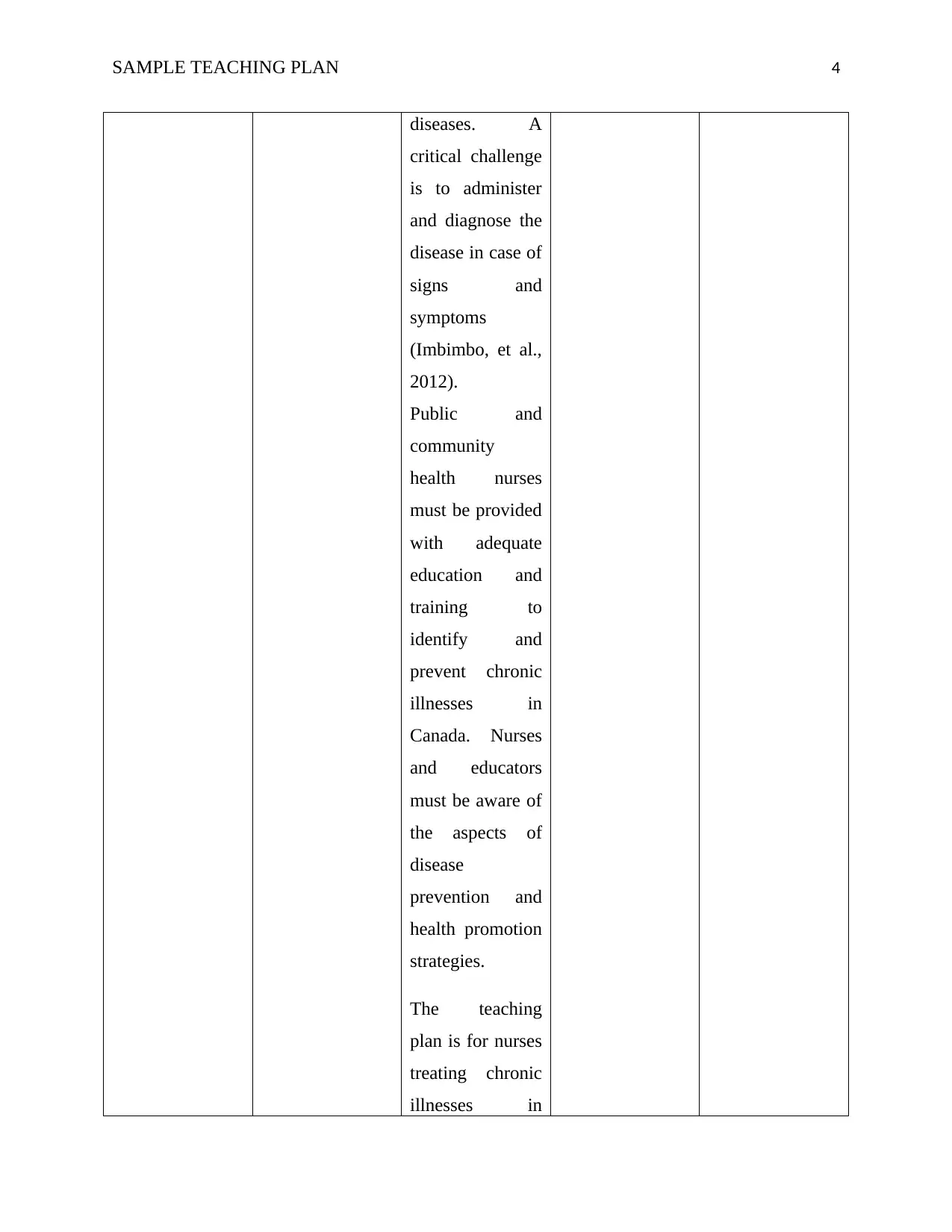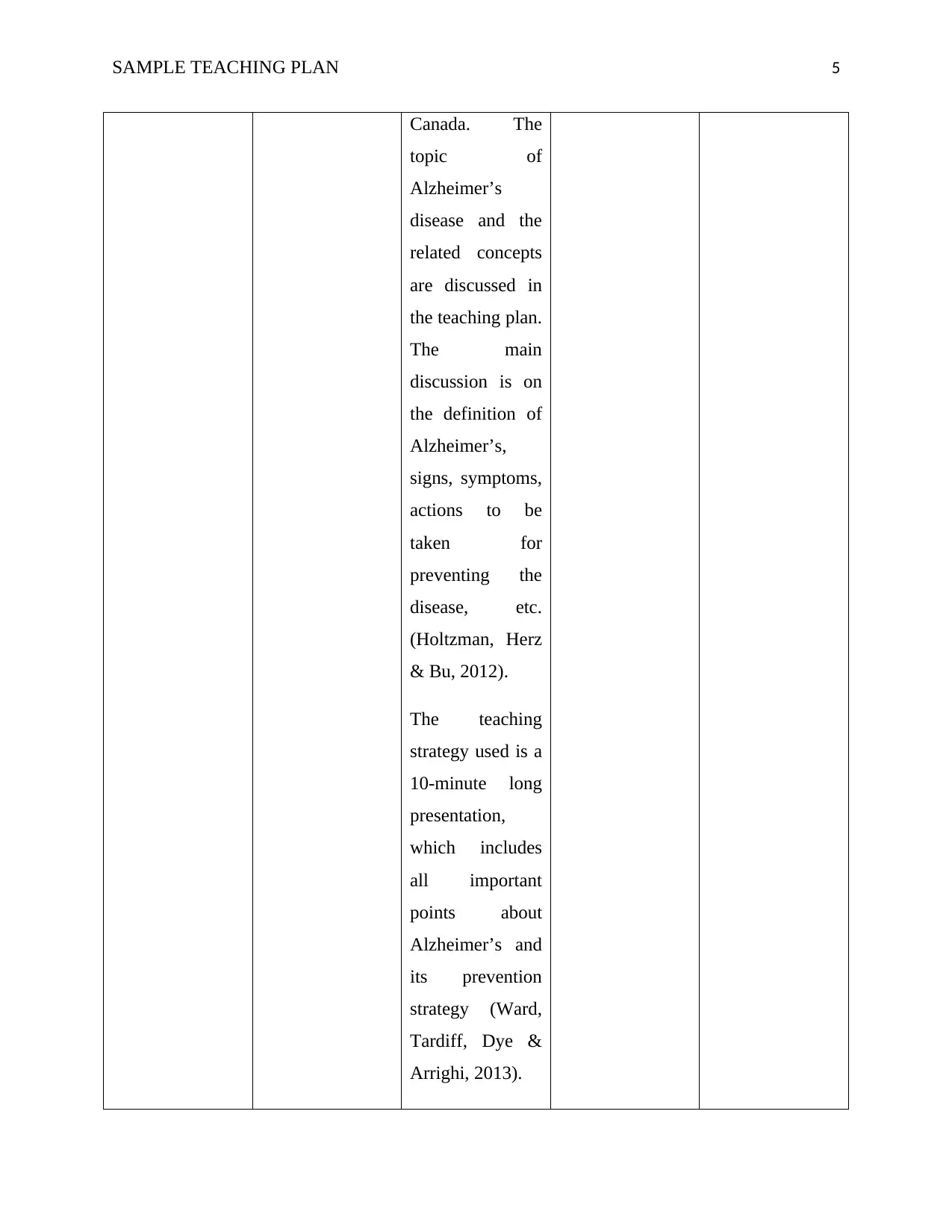Chronic Illness Teaching Plan: Alzheimer's Disease Prevention
VerifiedAdded on 2023/04/08
|7
|670
|359
Report
AI Summary
This teaching plan focuses on Alzheimer's disease in Canada, providing essential information for nurses and healthcare professionals. It covers the definition of Alzheimer's, its signs and symptoms, and necessary actions for prevention. The teaching strategy involves a concise 10-minute presentation that includes critical points about Alzheimer's and its prevention strategies. The plan emphasizes the importance of early diagnosis and appropriate treatments to manage the disease effectively, highlighting the role of public and community health nurses in identifying and preventing chronic illnesses. The evaluation strategy includes a rating system to assess the knowledge and confidence of healthcare providers in diagnosing and treating Alzheimer's, aiming to improve patient care and health outcomes.

Running head: SAMPLE TEACHING PLAN 1
STUDENT NAME:
STUDENT ID:
TOPIC: SAMPLE TEACHING PLAN FOR CHRONIC ILLNESS
DATE: 20-3-2019
STUDENT NAME:
STUDENT ID:
TOPIC: SAMPLE TEACHING PLAN FOR CHRONIC ILLNESS
DATE: 20-3-2019
Paraphrase This Document
Need a fresh take? Get an instant paraphrase of this document with our AI Paraphraser

SAMPLE TEACHING PLAN 2
Sample Teaching Plan for Chronic Illness in Canada
Topic Objectives Teaching
strategy
Evaluation
method
Timeframe
A. Definition of
Alzheimer’s
disease
B. Signs of
Alzheimer’s
C. Symptoms of
Alzheimer’s
D. Actions taken
for the
prevention of
Alzheimer’s like
a chronic disease.
The objectives of
teaching chronic
illness:
-To distinguish
the symptoms
and signs of
Alzheimer’s.
-To demonstrate
the ability to
perform
treatment for
Alzheimer’s.
The objective of
the teaching plan
is to clearly
define the
symptoms and
signs of chronic
disease and the
provision of
appropriate
treatments to
cure the disease.
A presentation is
prepared that
contains chronic
disease signs and
symptoms
(McKhann, et al.,
2011). The
presentation
includes pre-
dementia
information,
cause, signs,
symptoms,
pathophysiology,
diagnosis, and
prevention of
Alzheimer’s
(Spinney, 2014).
The teaching
strategy includes
knowledge about
chronic illness.
Education
provides
knowledge about
the signs and
The client needs
to identify
symptoms and
signs with the
rating system on
a scale of 0-10. If
the score is 0, the
confidence is
low, if the score
is 10, there is
complete
confidence in
working while
identifying the
signs and
symptoms of the
disease.
The rating
method is to
ensure that
nurses are aware
of the concepts
and topics that
are discussed.
The rating
method is on a
10 min
Sample Teaching Plan for Chronic Illness in Canada
Topic Objectives Teaching
strategy
Evaluation
method
Timeframe
A. Definition of
Alzheimer’s
disease
B. Signs of
Alzheimer’s
C. Symptoms of
Alzheimer’s
D. Actions taken
for the
prevention of
Alzheimer’s like
a chronic disease.
The objectives of
teaching chronic
illness:
-To distinguish
the symptoms
and signs of
Alzheimer’s.
-To demonstrate
the ability to
perform
treatment for
Alzheimer’s.
The objective of
the teaching plan
is to clearly
define the
symptoms and
signs of chronic
disease and the
provision of
appropriate
treatments to
cure the disease.
A presentation is
prepared that
contains chronic
disease signs and
symptoms
(McKhann, et al.,
2011). The
presentation
includes pre-
dementia
information,
cause, signs,
symptoms,
pathophysiology,
diagnosis, and
prevention of
Alzheimer’s
(Spinney, 2014).
The teaching
strategy includes
knowledge about
chronic illness.
Education
provides
knowledge about
the signs and
The client needs
to identify
symptoms and
signs with the
rating system on
a scale of 0-10. If
the score is 0, the
confidence is
low, if the score
is 10, there is
complete
confidence in
working while
identifying the
signs and
symptoms of the
disease.
The rating
method is to
ensure that
nurses are aware
of the concepts
and topics that
are discussed.
The rating
method is on a
10 min

SAMPLE TEACHING PLAN 3
symptoms of
chronic illnesses.
Canada has the
highest
interaction
between nurse
and patient due
to chronic
diseases like
Diabetes,
Alzheimer’s, etc.
It is important
that the experts
in chronic illness
treatments focus
on attaining
goals while
identifying the
disease and help
prevent the same
with medications
and treatments
(Bateman, et al.,
2012).
Implementing
effective plans
helps to curtail
the knowledge of
the cost burdens
and helps to
manage chronic
scale from 0-10,
with 10 being the
highest score that
determines
complete
awareness of
diagnosing the
signs and
symptoms of
Alzheimer’s and
having complete
confidence in
treating the
disease, which is
a challenging and
a critical
situation that
new nurses face
in health care
systems.
symptoms of
chronic illnesses.
Canada has the
highest
interaction
between nurse
and patient due
to chronic
diseases like
Diabetes,
Alzheimer’s, etc.
It is important
that the experts
in chronic illness
treatments focus
on attaining
goals while
identifying the
disease and help
prevent the same
with medications
and treatments
(Bateman, et al.,
2012).
Implementing
effective plans
helps to curtail
the knowledge of
the cost burdens
and helps to
manage chronic
scale from 0-10,
with 10 being the
highest score that
determines
complete
awareness of
diagnosing the
signs and
symptoms of
Alzheimer’s and
having complete
confidence in
treating the
disease, which is
a challenging and
a critical
situation that
new nurses face
in health care
systems.
⊘ This is a preview!⊘
Do you want full access?
Subscribe today to unlock all pages.

Trusted by 1+ million students worldwide

SAMPLE TEACHING PLAN 4
diseases. A
critical challenge
is to administer
and diagnose the
disease in case of
signs and
symptoms
(Imbimbo, et al.,
2012).
Public and
community
health nurses
must be provided
with adequate
education and
training to
identify and
prevent chronic
illnesses in
Canada. Nurses
and educators
must be aware of
the aspects of
disease
prevention and
health promotion
strategies.
The teaching
plan is for nurses
treating chronic
illnesses in
diseases. A
critical challenge
is to administer
and diagnose the
disease in case of
signs and
symptoms
(Imbimbo, et al.,
2012).
Public and
community
health nurses
must be provided
with adequate
education and
training to
identify and
prevent chronic
illnesses in
Canada. Nurses
and educators
must be aware of
the aspects of
disease
prevention and
health promotion
strategies.
The teaching
plan is for nurses
treating chronic
illnesses in
Paraphrase This Document
Need a fresh take? Get an instant paraphrase of this document with our AI Paraphraser

SAMPLE TEACHING PLAN 5
Canada. The
topic of
Alzheimer’s
disease and the
related concepts
are discussed in
the teaching plan.
The main
discussion is on
the definition of
Alzheimer’s,
signs, symptoms,
actions to be
taken for
preventing the
disease, etc.
(Holtzman, Herz
& Bu, 2012).
The teaching
strategy used is a
10-minute long
presentation,
which includes
all important
points about
Alzheimer’s and
its prevention
strategy (Ward,
Tardiff, Dye &
Arrighi, 2013).
Canada. The
topic of
Alzheimer’s
disease and the
related concepts
are discussed in
the teaching plan.
The main
discussion is on
the definition of
Alzheimer’s,
signs, symptoms,
actions to be
taken for
preventing the
disease, etc.
(Holtzman, Herz
& Bu, 2012).
The teaching
strategy used is a
10-minute long
presentation,
which includes
all important
points about
Alzheimer’s and
its prevention
strategy (Ward,
Tardiff, Dye &
Arrighi, 2013).

SAMPLE TEACHING PLAN 6
References
References
⊘ This is a preview!⊘
Do you want full access?
Subscribe today to unlock all pages.

Trusted by 1+ million students worldwide

SAMPLE TEACHING PLAN 7
Bateman, R.J., Xiong, C., Benzinger, T.L., Fagan, A.M., Goate, A., & Fox, N.C. (2012). Clinical
and biomarker changes in dominantly inherited Alzheimer’s disease. N Engl J
Med,367(9), 795-804.
Holtzman, D.M., Herz. J., & Bu, G. (2012). Apolipoprotein E and apolipoprotein E receptors:
Normal biology and roles in Alzheimer disease. Cold Spring Harb Perspect Med, 2(3).
Imbimbo, B.P., Ottonello, S., Frisardi, V., Solfrizzi, V., Greco, A., Seripa, D., Pilotto, A., Panza,
F. (2012). Solanezumab for the treatment of mild-to-moderate Alzheimer disease. Expert
Rev Clin Immunol, 8(2), 49-135.
McKhann, G.M., Knopman, D.S., Chertkow, H., Hyman, B.T., Jack, C.R., Kawa,s C.H. (2011).
The diagnosis of dementia due to Alzheimer’s disease: Recommendations from the
National Institute on Aging-Alzheimer’s Association workgroups on diagnostic
guidelines for Alzheimer’s disease. Alzheimers Dement, 7(3), 9-263.
Spinney, L. (2014). Alzheimer’s disease: The forgetting gene. Nature, 510(7503), 26-81.
Ward, A., Tardiff, S., Dye, C., Arrighi, H.M. (2013). Rate of conversion from prodromal
Alzheimer’s disease to Alzheimer’s dementia: A systematic review of the literature.
Dement Geriatr Cogn Disord Extra,3, 32-320
Bateman, R.J., Xiong, C., Benzinger, T.L., Fagan, A.M., Goate, A., & Fox, N.C. (2012). Clinical
and biomarker changes in dominantly inherited Alzheimer’s disease. N Engl J
Med,367(9), 795-804.
Holtzman, D.M., Herz. J., & Bu, G. (2012). Apolipoprotein E and apolipoprotein E receptors:
Normal biology and roles in Alzheimer disease. Cold Spring Harb Perspect Med, 2(3).
Imbimbo, B.P., Ottonello, S., Frisardi, V., Solfrizzi, V., Greco, A., Seripa, D., Pilotto, A., Panza,
F. (2012). Solanezumab for the treatment of mild-to-moderate Alzheimer disease. Expert
Rev Clin Immunol, 8(2), 49-135.
McKhann, G.M., Knopman, D.S., Chertkow, H., Hyman, B.T., Jack, C.R., Kawa,s C.H. (2011).
The diagnosis of dementia due to Alzheimer’s disease: Recommendations from the
National Institute on Aging-Alzheimer’s Association workgroups on diagnostic
guidelines for Alzheimer’s disease. Alzheimers Dement, 7(3), 9-263.
Spinney, L. (2014). Alzheimer’s disease: The forgetting gene. Nature, 510(7503), 26-81.
Ward, A., Tardiff, S., Dye, C., Arrighi, H.M. (2013). Rate of conversion from prodromal
Alzheimer’s disease to Alzheimer’s dementia: A systematic review of the literature.
Dement Geriatr Cogn Disord Extra,3, 32-320
1 out of 7
Related Documents
Your All-in-One AI-Powered Toolkit for Academic Success.
+13062052269
info@desklib.com
Available 24*7 on WhatsApp / Email
![[object Object]](/_next/static/media/star-bottom.7253800d.svg)
Unlock your academic potential
Copyright © 2020–2025 A2Z Services. All Rights Reserved. Developed and managed by ZUCOL.





